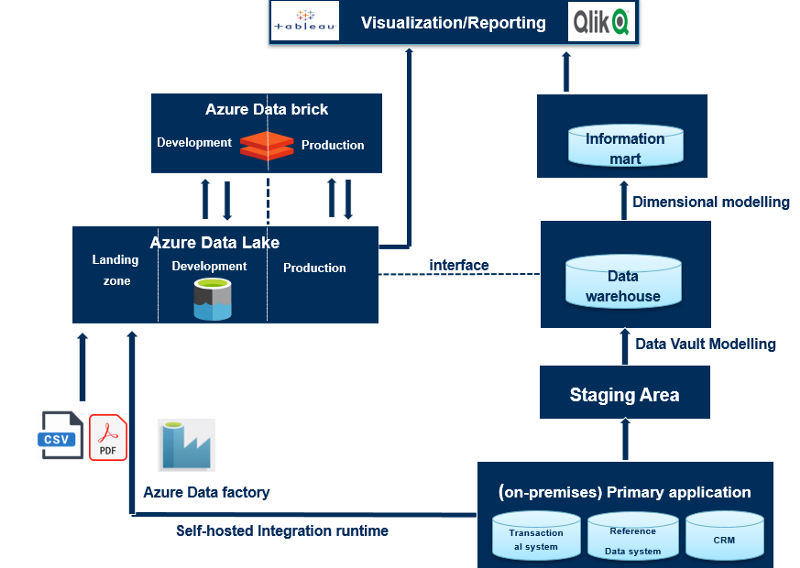
Update 01/08/2020: I removed the process to do Business Intelligence because it resembles the internal process being used at my current company, which is considered as internal information.
What the heck is Business Intelligence?
 Author illustration based on Photo by Sebastian Herrmann on Unsplash
Author illustration based on Photo by Sebastian Herrmann on Unsplash
Business Intelligence (BI) is a term which is defined in multiple ways and it’s tough to answer with a very precise statement and scope. However, in a simple language, BI is truly about using data of yesterday and today to make better decisions about tomorrow. It can be understood as the function which ensures that raw data is transformed into meaningful information that provides insights and enables decision-making. If we think about what companies have been trying to do for a long time, very often we hear about investing in technology and tools that are supposed to solve business problems with data and analytics. BI, however is less about technology and tool and more about using data , technology and tools to create business insights.
In a nutshell, BI involves gathering functional business requirements and translating it into technical solutions by designing data models, doing the ETL — Extract, Transform and Load process to convert raw data from operational source systems to meaningful information and to bring those information to an analytics/destination database, which can be used to visualize in the form of a real-time automatic dashboard. This is done in a business to make informed decisions based on the past data rather than on a “Gut instinct”.
What is the ultimate output of BI?
- BI provides a single version of truth
The story of A Single Version of Truth is the story of a data dictionary and data source, which is all about the meaning of data which should be agreed across an enterprise. And not less important, where to source the data. Let me give you an example. I used to work for this bank who can not answer a simple question such as: How many unique customers does it have? Depending on who you asked it, you will receive a different number. Having an unique source of truth is therefore a must. Instead of going through multiple spreadsheets with different numbers and doing reconciliations, BI product provides users a real-time automatically updated and consistent report.
2. BI provides descriptive analytics — Business intelligence is descriptive because it tells you what’s happening now and what happened in the past. It informs how a company is doing with regard to its set KPIs and metrics. For instance, BI product can tell a manager how the company is making sales and how far it is from reaching its set goals. This information is usually provided in the form of dashboards that include bar graphs, line charts and the like, which gives users the most important information at one glance.
3. BI provides diagnostic analytics: Diagnostic analytics is about giving in-depth insights and answering the question: Why something happened? BI dashboards provides drill-down functionality — which mean, from high-level overview, users can slice-and-dice the information from different angles, to the very details to figure out why things happened.
Bi does not tell you what’s going to happen in the future.
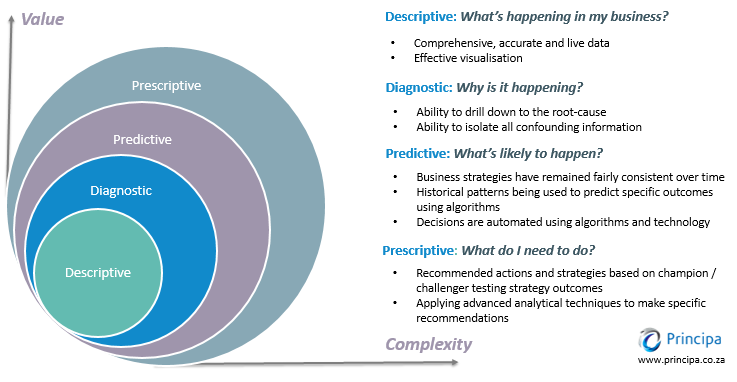 Four types of data analytics. Source Principa
Four types of data analytics. Source Principa
Data Warehouse, Data Lake: schema-on-write and schema-on-read
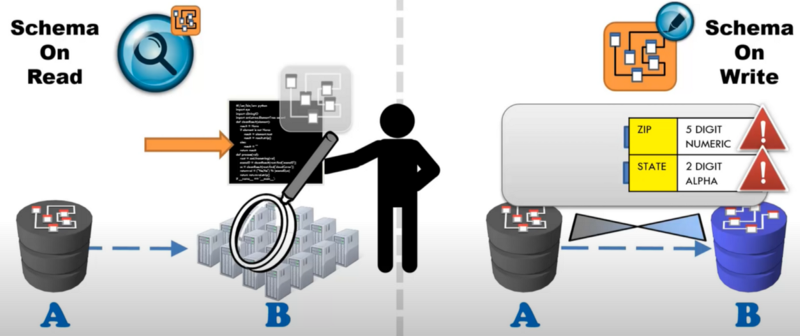 Schema on read versus Schema on write. Source: Intricity — Hadoop and SQL comparison.
Schema on read versus Schema on write. Source: Intricity — Hadoop and SQL comparison.
Data warehouse Architect
Business intelligence is a term commonly associated with data warehousing. If BI is the front-end, data warehousing system is the backend, or the infrastructure for achieving business intelligence. As such, we will first discuss BI in the context of using a data warehouse infrastructure.
The ultimate purpose of a BI implementation is to turn operational data into meaningful information. As raw data is scattered from different operational databases, which are designed and optimized for applications to run rather than for analysis purposes. Sometimes in order to get one data field, you would have to do ten joins! And here it goes. People come up with a solution called a central data storage — data warehouse.
Data warehousing solution emerged in the 1980s, which is optimized for providing information or insights. The data warehouse is a destination database, which centralizes an enterprise’s data from all of its source systems. It is a relational database because we can join data from different tables using the joint field as presented in the physical data model. The data base schema defines relations between different tables. Typical SQL databases include mysql and postgresql.
As mentioned, the data sources connect into the data warehouse through a ETL process, known as Extract, Transform, and Load. A data warehouse follows the schema-on-write pattern, where the design fits the answers to the expected questions. Put differently, a data warehouse collects data coming from primary applications with predetermined structure and schema. In Data warehouse architecture, when we move data from a database A to database B, we need to have some information beforehand about the structure of database B and how to adapt the data of database A to fit the structure of data B, for instance to fit the data type of the database B, etc.
Three-layer Datawarehouse Architecture
Data warehouse engineers can use various architectures to build data warehouse. Common data warehouse architectures are based on layer approaches. The well-known three-layer architecture is introduced by Inmon, which includes the following components:
The first layer in line is Staging area. This is a data base used to load batch data from source system. Its purpose is to extract the source data from the source systems/primary applications to reduce the work-load on operational system. Staging Area consists of tables that mirror the structures of the source systems, which include all the tables and columns of the sources, including the primary key. No functional business rules is applied here. However, some hard technical business rules are enforced at this stage, for instance, data type matching (string length or unicode characters). This technical business rules do not change the meaning of data, but rather only the way data is stored.
The second layer is the data warehouse layer, which is the place where the transformation — applying functional business rules happens. These functional business rules modify incoming data to fit the business requirements. The earlier the business rules are implemented a data warehouse architecture, the more dependencies it has on higher layers on top of the data warehouse. In data warehouse modelling, you will often hear about Dimensional modelling or Data Vault modelling.
Data Vault modelling technique was invented by Dan Linstedlt in the 1990s. It is based on three basic entities type including the Hubs, The Links and The Satellites. The Hubs are the main pillars of Data Vault Model, which present the business keys being used by the business users to identify business objects. Examples of business keys include: Customer identifier, product identifier, employee badge number etc. The link ties the Hubs together and stores the relationship between different Hubs (business objects). Satellites is know as the standard place to store metadata. Apart from that, Satellites store all the attributes that describe a business object or a relationship. They add the business contexts at a period of time to Hubs and Links. However, this business context changes over time and the goal of having satellites is also to track those changes and store historical data.
On top of the data warehouse, _there is a dimensional model which builds up the data mart layer _— the layer used to present the data to the end-user. I think it makes more sense to call it information mart rather than data mart. The key concepts of dimensional modelling include fact entity and multiple dimension entities, which is a standard technique for building the information mart since it is very straightforward for end-users to understand. In dimensional modelling, you will often hear about star schema — meaning one fact table referencing any number of dimension tables. Fact table represents what happens, orders, amounts transactions, meanwhile, dimension entities contain different attributes/fields that constitute the facts.
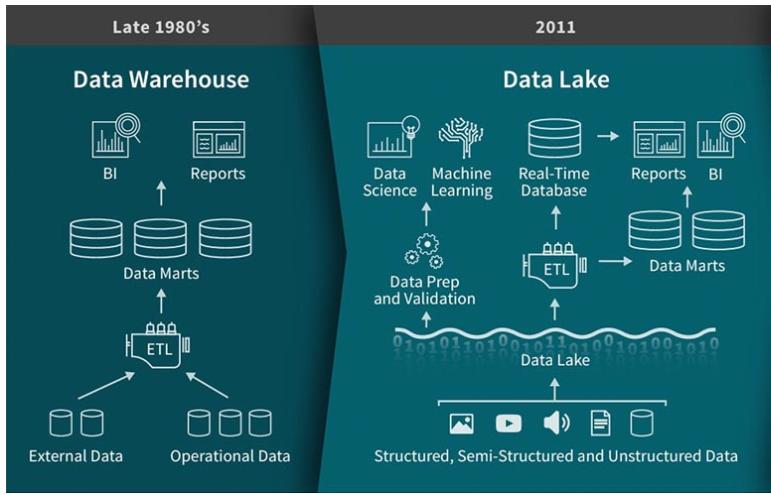 Source: “What is a Lakehouse?” by Databricks
Source: “What is a Lakehouse?” by Databricks
Data Lake architecture
Because data that goes into data warehouses needs to go through a strict governance process before it gets stored, adding new data elements to a data warehouse means changing the design, implementing or refactoring structured storage for the data and the corresponding ETL to load the data. With a massive amount of data, this process could require significant time and resources. This is where a data lake concept comes into the picture and becomes a game-changer in big data management.
The concept of data lake emerges in the 2010s, which, in a simple language, is the idea that all enterprise’s structured, unstructured and semi-structured data can and should be stored in the same place. Apache Hadoop is an example of data infrastructure that allows to store and process massive amounts of data, both structured and unstructured; which enables the Data Lake architecture.
 Example of DWH and Data Lake architecture. Illustration by author based on MS Azure document and Daniel Linstedt ‘s book.
Example of DWH and Data Lake architecture. Illustration by author based on MS Azure document and Daniel Linstedt ‘s book.
Data lake has schema on read approach. It stores raw data and is set up in a way that does not require defining the data structure and schema in the first place. Put differently, when we move data to data lake, we just bring it in without any gate keeping rules and when we need to read the data, we apply the rule to the code that reads the data rather than configuring the structure of data ahead of time. Instead of the typical Extract, Transform and Load in data warehousing, in the world of data lake, the process is Extract, Load and Transform. Data Lake is utilized for cost efficiency and exploration purpose. As such, a Data Lake architecture enables business to gain insights not only from the processed and governed data but also from raw data that was not available for analysis before. From that, raw data exploration can potentially trigger business questions. However, the biggest concern with data lake is that, without appropriate governance, data lakes can quickly turn into unmanageable data swamps. Put it differently, without knowing how the water is in a lake, who would want to go swim in it? Business users can’t not utilize the data lake if they don’t trust the data quality of that lake .
 Source; Datavercity through slideshare
Source; Datavercity through slideshare
Recently the trend of companies that want to benefit from a data lake architecture in a more conservative way has emerged. These companies are stepping away from the ungoverned “free-entry” approach and instead developing a more governed data lake.
The data lake can contain two environments: an exploration/development and production environment. Data will be explored, cleansed, transformed in order to build machine learning model, build functions and other analytics purposes. Data such as metrics, functions that have been generated by the transformation process will be stored in the production part of data lake.
Another trend is, rather than pouring all raw data into the lake, the governed data lake only allows ‘verified’ data to get into it. Essentially, a governed data lake architecture does not restrict the types of data that are stored in it, meaning that governed data lakes still comprise multiple data types including unstructured and semi-structured data like XML, JSON, CSV. However, the key is to make sure that no data is stored in the lake without being described and documented in business glossary, which will give some confidence to the users about the quality and meaning of data.
To provide this layer of governance, a business glossary tool has to be in place to document the meaning of the data. More importantly, there needs to be a governance process around this — which is all about roles and responsibilities, for instance, who owns the data, who defines it, who will be responsible for any data quality issues. Going for this approach will be time-consuming because defining data itself can be a long process since it involves people from different disciplines across an enterprise.
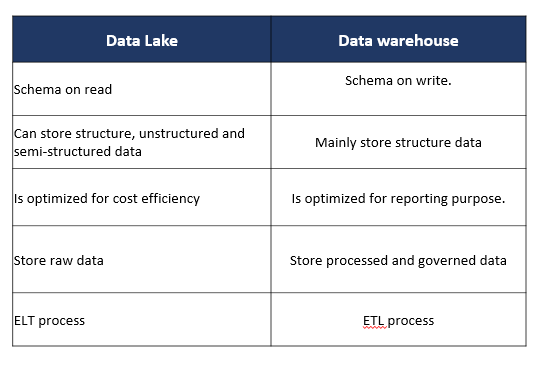 Data Lake and Data Warehouse comparison. Illustration by author.
Data Lake and Data Warehouse comparison. Illustration by author.
On-premise and cloud service
In the old days, companies usually rely on self-host-data-centre. During data processing, a huge amount of data has to be processed and data processing runs on a cluster of machines at the same time rather than on one computer. This on-premise storage set-up centre requires lots of serves and big computers and enough processing power for peak moments. It also means that, in quieter times, much of the processing power remains unused. Therehore, on-premise systems have huge up-front installation cost but at the same time, their capacity can not always be fully used. Not only that, maintaining this requires a whole dedicated application team to take care of these primary systems, to fix production issues and to reduce the downtime.
These huge disadvantages of on-premise storage has made the idea of using cloud becomes so appealing. Many companies have moved to the cloud as a way of cost optimization. The rise of building data infrustructure on the clouds, for instance using Azure and AWS has completely changed an enterprise’s big data capabilities. Instead of maintaining CPUs and storage in their data center, companies only need to rent the cloud resources, for example, the storage they need at the time they need it. The cloud providers take care of maintaining the underlying infrastructure. When cloud-service users are done using the resouces, they can give them back and are billed only for what they use.This makes it very easy to scale since if things are slowing down, companies can assign some more virtual machines to do data processing for instance. With cloud storage, enterprises don’t have to invest in new machines, infrastructure, or replace aging servers. Another reason for using cloud storage is database reliability. In the worse case, for example, a fire can happen at your data centre. To be safe, you need to replicate your data to different geographical locations. This brings a bunch of logistic problems. On these needs, companies specilizing in this kind of service were born. We call them “cloud-service providers”. There are three big players on cloud-service provider market. First and foremost, Amazon Web service (AWS) is the market leader, who takes up 32% of market share in 2018. Second position on the run belongs to Microsoft Azure that owns 17% of the market share and third in popularity is Google Cloud Services who owns 10% of market share.
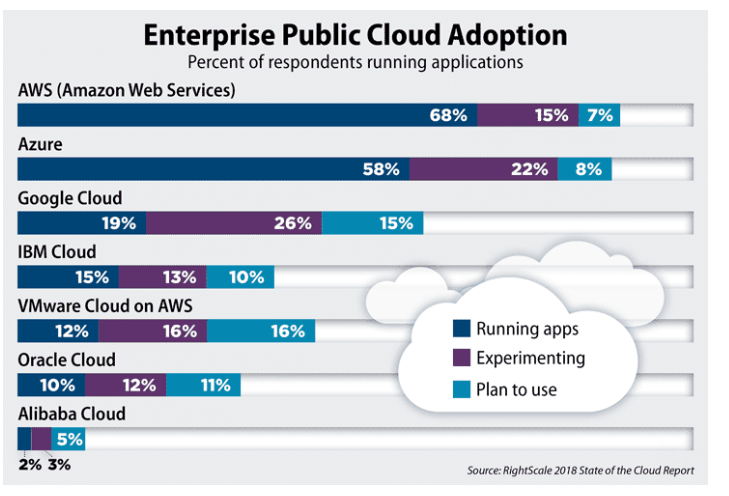
What do these cloud-service providers have to offer?
There are a bunch of cloud services that all have different use cases. The most simple service is storage, which allows cloud-service users to upload all type of files on the cloud. Storage services are typically cheap since they don’t provide much functionality other than storing the files reliably. AWS hosts S3 as a storage service. Azure has Blob storage and google has Cloud Storage. The second service is computation service which allows you to perform computation on the cloud. Essentially, you can start up a virtual machine and use it as you wish. Computation service is often used to host web servers and performing calculations, for example. AWS provides EC2 as computation service, Microsoft Azure uses Virtual machines and Google has Compute Engine. Cloud-service providers also host databases. For instance, companies can start exploring the cloud by moving their existing applications to virtual machines that run in Azure. Another use cases of cloud service is Artificial Intelligence and Machine Learning. Azure for example provides Azure Machine Learning service which is a cloud-based environment you can use to develop, train, test and deploy machine learning models.
Can a Data Lake replace Data warehouse for BI?
It is no doubt that a Data Lake offers several benefits over data warehouse, particularly for dealing with big data and cost efficiency. However, without knowing about the data quality in data lakes, business users can’t not trust in that data. Lots of data scientists often don’t realize that getting the raw data from multiple sources to be ready — clean and high quality for modelling usually takes 80% of the time. Meanwhile, the architecture and discipline of Data Warehouses that provide governed and good quality data can’t be ignored. There is still a strong and permanent demand for a core set of KPIs that define how a business is doing, which are also needed for reporting, especially regulatory reporting purposes. Such information demands highly governed information.
At the end of the day, the most crucial question about what companies want to achieve in their business strategy with data and technology has to be crystal clear. For example, if a company, in their business and data strategy, does not plan to be involved in data science, there is no point of investing in Data Science/Analytics platform that allows AI and Machine Learning to happen. Or companies can govern all its data in a business glossary platform and helicopter them into a Data Lake, but if they don’t know why, I doubt if that is going to create value.
Thank you for reading. I hope this high-level overview helps you understand more about BI and the architecture behind it.
References:
[1] Building a Scalable Data Warehouse with Data Vault 2.0
[2] 1keydata — Datawarehousing concepts
[3] https://databricks.com/blog/2020/01/30/what-is-a-data-lakehouse.html
[4]. Post by Phoebe Wong on Medium.
[5]. Putting data lake to work.
Originally published on Towards Data Science
 Photo by
Photo by 

